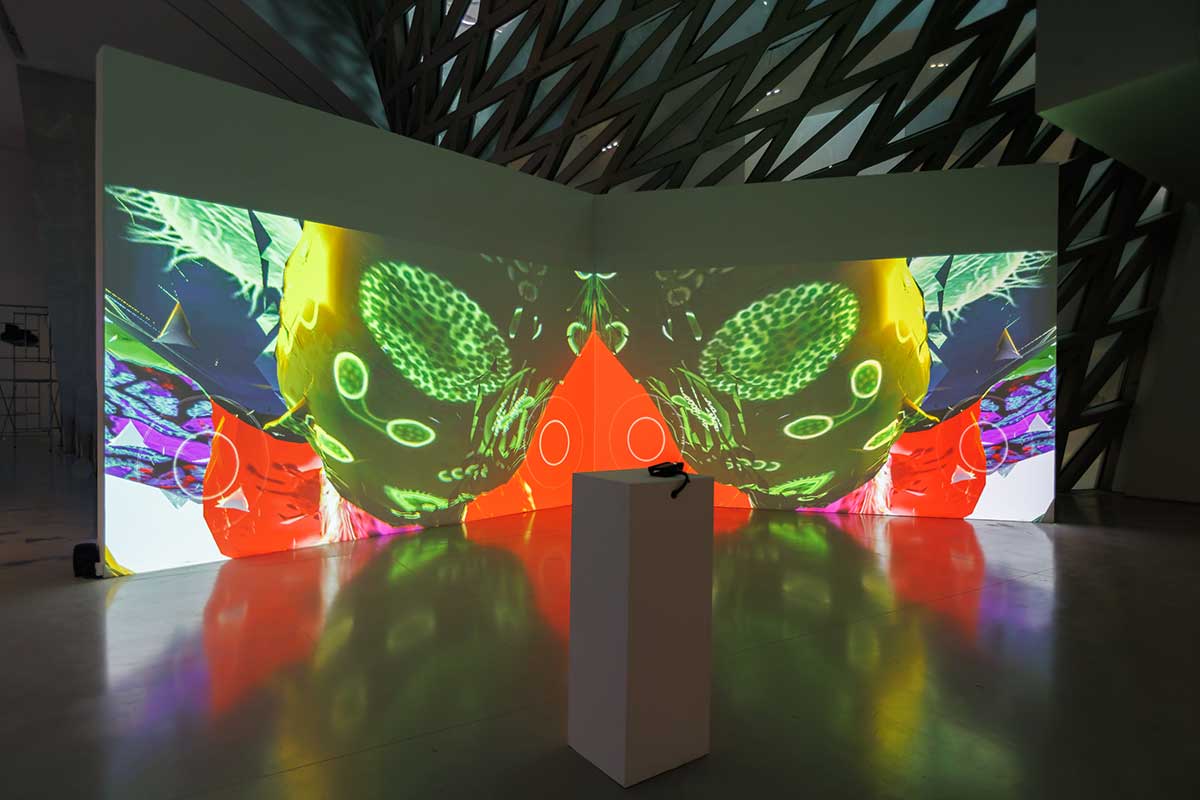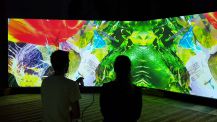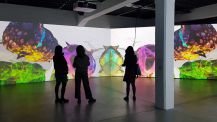Topologies of the Real - Techne Shenzhen 2023
Shenzhen Museum of Contemporary Art and Urban Planning, Shenzhen, ChinaCurator: ZHANG Ga

Exhibition view of “Time to Nest, Time to Migrate” by Marc Lee, Courtesy of Shenzhen Museum of Contemporary Art (MoCAUP)

MoCAUP, Shenzhen
Chinese adaptation of the interactive installation "Time to Nest Time to Migrate", for the Topologies of the Real, Shenzhen Museum of Contemporary Art and Urban Planning (MoCAUP)
For this show, we have adapted the app into Chinese - texts and voices.
Thank you so much for this great collaboration:
🙏ZHANG Ga curator
🙏Zhengxu translation
🙏Mogu voice
🙏Shervin Saremi sound
🙏BILLY YB WANG installation setup
🙏Pro Helvetia Shanghai
Topologies of the Real is conceived as a three-part exhibition under the rubrics of “Reality Interrupted,” “Datumsoria: The Return of the Real,” and “Multiverse: Ecology without Nature.” ZKM’s Art in Motion: Masterpieces with and through Media further extends the media-historical fundamentals of “Reality Interrupted.” The exhibition examines the trajectories of how artistic imagination has challenged and redefined the notion of reality under the technological construct of spacetime which has manifestly accelerated since the mid-twentieth century and how such artistic endeavors have brought to light the political, economic and cultural conundrums and creative potentialities implicated by a flattened and instantaneous digital contemporary. Artworks conceived and produced during the past two years amidst the harrowed existence will be included to bring to the fore a new exigency that is catastrophically larger than human capacity while at the same time prompting redeeming hopes for the solidarity of humans and things in a symbiotic worldmaking.
Reality Interrupted & Art in Motion: Masterpieces with and through Media
“Reality Interrupted” and Art in Motion: Masterpieces with and through Media underscore the notion that media art is art based on technical devices and inseparable from apparatus and machines. With motion as an essential characterization of machines, this group of artworks sketches out an art history that evolved from the introduction of photographic apparatus, further augmented by moving images in cinematographic aggregation and the cybernetic feedback systems which foreshadowed the today’s ubiquitous interactivities of all kinds. The emergence of the information society in the mid-twentieth century, signaled by satellite communications technologies and early implementation of distributed network nodes (albeit a Cold War byproduct), furthermore accelerated the speed of movement, compressing space and time into a pure technical construction in which distance disappears and time becomes timeless, culminating in the millennial chaos of digital capitalism exacerbated by the catastrophic image of the fall of the Twin Towers, interrupting and suspending our received concept of reality. The hundred-year long history of art with and through media and its ramifications are encapsulated in the first chapter of the exhibition.
Datumsoria: The Return of the Real
As a neologism conjugated from datum and sensorium, datumsoria denotes a new perceptual space immanent to the information age. It speaks the logic of the new real, a reality predicated on the virtual force of the binary impulse, of the generativity of ones and zeros from whose plane of immanence comes forth a hardening of shapes and forms. “Datumsoria: the Return of the Real” as the second part of the exhibition attests to the formidable presence of a planetary membrane: the network that has forever changed the rules of the game in work and play, in politics and economics. Precipitating sentient residues and invoking emotive potentials, in the flux of electronic impulses there emerges a consciousness of technical autopoiesis that is capable of subjectivity of another order and inquisitive about the new ethics of another dimension. This exhibition component also signals that the politics of the real no longer only lie in the sphere of actual bodies and social sites recognized in the form of the traumatic and abject subject as the predominant subject of contemporary experience and object of artistic inquiry, but also alludes to who has ownership of this new reality that is constructed by the materiality of bits and bytes and the algorithmic power of the digital.
Multiverse: Ecology without Nature
The exhibition’s third chapter borrows its subtitle from the eponymous book by Timothy Morton, Ecology without Nature, albeit skewing away from the author’s cultural critique of nature, to solicit a speculative yet probable reality of multiple universes of entirely different dimensions and materialities as subatomic forces and string theory attest. In this multitude of ecologies and environments, much like how quantum reality topples the familiar and perceivable, the nature of Nature, as particles gush through the fabled double slit test to land in juxtaposing distances infinitely far and near simultaneously, in which erratically fluctuating time and space once again sabotage human intellect, an oxymoron becomes a new trope. In these parallel timespaces, in between the cosmological horizons, humanity’s laughs and cries, machine mumbles and chirps, cultural myths and anomalies, self-styled A.I. diligence and bio-eccentrics are all making their own worlds of the real, their habitats of survival and triumph.
— ZHANG Ga, Curator
Exhibited Artwork
Time to Nest Time to Migrate
Mobile App as Interface for Interactive InstallationsWith this 360° New Media Art Mobile VR App Time to Nest Time to Migrate you fly through your own inner world. What happens in there? Bacteria, cells, fungi, parasites, phages, protists, prions, viruses communicate. Do they determine what we are? Not scientific, but rather fake scientific, philosophical and emergency poetically. (We know that we know nothing, we know). A little dance of life and more …

Reithalle, St. Moritz

HEK, Basel

MoCAUP, Shenzhen